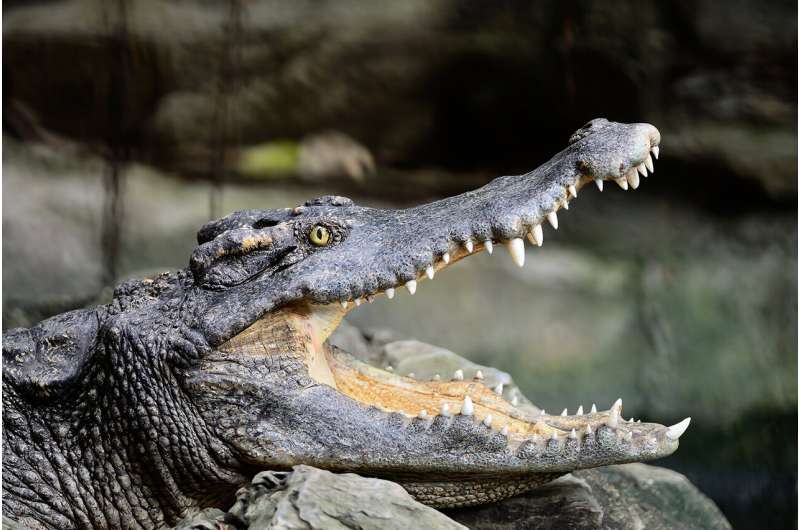What did ancient crocodiles eat? Study says as much as a snout can grab

While most people imagine alligators and crocodiles as being much the same now as they were during the age of dinosaurs, digging into the fossil record shows much more diverse species through time. Semiaquatic ambush predators resembling modern alligators and crocodiles are seen in fossil relatives going back to the Jurassic period, but the group also includes oceangoing crocs with flippers and tail flukes, heavily armored pug-faced crocs, long-legged crocs that ran on land, and giant crocs with tiny teeth and surfboard-shaped skulls.
Many of these odd adaptations seem to be associated with what the animals were eating, but how do scientists study the diet of animals that have been dead for millions of years?
Two researchers—one from the University of Tennessee, Knoxville, and one from Stony Brook University—have tried to tackle this question by bringing together mathematical analyses of the animals' shapes, surveys of modern crocodiles' diet, modeling methods for reconstructing the diet of fossil groups, and forensic-style interpretations of damaged bones from the distant past.
"We used to put modern crocs into two ecological bins: slender-snouted groups who eat only fish and broader-snouted groups who eat pretty much whatever they want," said paleontologist Stephanie Drumheller, an adjunct assistant professor in UT's Department of Earth and Planetary Sciences and coauthor of the paper, published in Zoological Journal of the Linnean Society. "The reality is a lot more complicated."
Slender-snouted crocodiles, such as Indian gharials and freshwater crocodiles, actually eat all sorts of animals other than fish, though they do tend to stick with smaller prey relative to their body size. Among the crocs that eat larger prey, the researchers found an unexpected split. Broad V-shaped snouts, like those found in American crocodiles, correspond with animals that are able to eat prey species up to their own size. More U-shaped snouts, like those seen in American alligators, can often be found in species that take down even larger prey—sometimes close to twice their own body weight.
"Several of these fossil groups had skulls and teeth wildly different from living species. This suggests that the way they fed also differed dramatically," said coauthor Eric Wilberg, an assistant professor in Stony Brook University's Department of Anatomical Sciences. Among these are a group of extinct crocs that lived in the oceans. While they had slender snouts similar to those of living gharials, their eyes were positioned more on the side of the head, and the part of the skull that houses the jaw muscles was enlarged. This suggests they were not ambush predators like modern crocodylians.
Another group consists almost exclusively of species that lived on land. These crocs had flattened, serrated teeth, like those of carnivorous dinosaurs, and eyes positioned more on the side of the head.
Paleontologists can't observe feeding in extinct groups, but the fossil records sometimes provide snapshots of this behavior.
"Crocodiles and their relatives are pretty messy eaters," said Drumheller. "That's great for us, because they'll often leave broken, bitten bones behind for paleontologists to find."
Most of these fossil bite marks line up nicely with the idea of crocodiles and their relatives eating within their expected weight classes. The fossils that don't fit may be evidence of scavenging, a behavior that is rarely testable in the fossil record.
Some crocodile groups remain mysterious. No fossil bite marks exist for the stubby-faced crocs, whose complex teeth and weak jaws suggest they might have been plant eaters, or for the surfboard-headed ones, which had tiny teeth and may have sported pelican-like pouches under their long, wide jaws.
"Crocodiles and their relatives have long been thought of as unchanged for hundreds of millions of years, and as a result they have received less scientific attention than other groups like dinosaurs and mammals," said Wilberg. Renewed interest in the group has consistently demonstrated a complex evolutionary and ecological history, going far beyond the semiaquatic ambush predators alive today.
More information: Zoological Journal of the Linnean Society (2019). DOI: 10.1093/zoolinnean/zlz081 , academic.oup.com/zoolinnean/ad … nnean/zlz081/5579349
Journal information: Zoological Journal of the Linnean Society
Provided by University of Tennessee at Knoxville




















